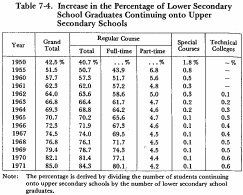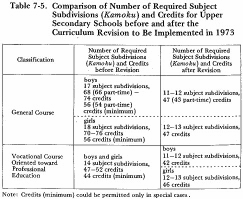- 現在位置
- トップ > 白書・統計・出版物 > 白書 > JAPAN'S MODERN EDUCATIONAL SYSTEM > 4 The Expansion and Diversification of the Upper Secondary Schools
4 The Expansion and Diversification of the Upper Secondary Schools
The percentage of students continuing their education beyond the compulsory schools continued to increase steadily in the years after 1952 and by 1971 had reached 85.0% (See Table 7-4.). This growth, in conjunction with the influx of the baby boom wave into the upper secondary schools from 1963.secured a more prominent place for upper secondary schools within the national educational system. The first half of thel960s in particular saw a number of measures taken on their behalf. By this time the percentage of students continuing onto upper secondary schools exceeded 60%; the economy had achieved a high growth rate, and the social demand for upper secondary school education was strong. In 1961 when the expansion of the upper secondary schools really began, the Law concerning the Establishment of Local Public Upper Secondary Schools, Their Proper Distribution, the Standard for the Fixed Number of Their Educational Personnel, and Other Matters was promulgated on November 6, 1961, and put in force on that day. Moreover, the financial base for these school was assured by a local allocation tax graft and further improvements were provided for in a five-year plan beginning in 1967.
The 1947 Courses of Study for elementary and lower and upper secondary schools were replaced by the 1951 Courses of Study for these schools and later revisions of the Course of Study for upper secondary schools were made generally followung similar revisions of the Courses of Study for the elementary and lower secondary schools: the Outline of the 1955 Course of Study for Upper Secondary Schools was published in December, 1955, for implementation from April,1956' the 1960 Course of Study for Upper Secondary Schools was announced in October, 1960, for implementation from April, 1963, and the 1970 Course of Study for Upper Secondary Schools was announced in October, 1970, for implementation from April, 1973 (See Table 7-5.). These revisions were intended to make the content of upper secondary school education more appropriate for the changing society through the development of diversified scholastic aptitudes, as well as the promotion of greater individual adaptability and achievement.
Table 7-4. Increase in the Percentage of Lower Secondary School Graduates Continuing onto Upper Secondary Schools

Table 7-5. Comparison of Number of Required Subject Subdivisions (Kamoku) and Credits for Upper Secondary Schools before and after the Curriculum Revision to Be Implemented in 1973

As a means of making upper secondary school education readily available to working youths, the Law for the Promotion of Upper Secondary School Part-time and Correspondence Education was promulgated on August 18, 1953, and put in force on that day. Also government subsidies were provided for school meals in the evening and to compensate teachers overseeing these programs. Based on a revision of the School Education Law, which was promulgated on October 31, 1961, a cooperative system was started in May, 1962, between the part-time and correspondence schools on the one hand and the technical education facilities of business enterprises on the other, whereby study at technical education facilities designated by the Minister of Education was recognized as the equivalent of similar subjects offered in the regular upper secondary schools. This cooperation helped to lighten the burden on working youths when they participated in part-time and correspondence upper secondary education.
In fact, the number of students enrolled on a part-time basis peaked at 577,162 in 1953. Thereafter, the steady increase in the number of students attending full-time schools brought a proportionate decrease in part-time attendance, which numbered only 342,726 by 1971. Correspondence schools, on the other hand, increased their offerings to the point where students could complete upper secondary education solely via correspondence, and the use of television and radio made the correspondence method of education more accessible to potential students. Other measures to make post-compulsory education more available to working youths included the use of a combination of part-time and correspondence systems and the introduction of double and even triple shifts to be shared by the working students.
Vocational education which had declined as a result of the emphasis placed on general education in the immediate postwar period, was greatly strengthened by the enactment of the Vocational Education Promotion Law, which was promulgated on June 11, 1951, and put in force on that day. Throughout the decade of the 1950s, and also through the early l960s, there was a sharp increase in the number of schools and courses providing mainly vocational education. This growth was in response to several factors: technological innovation, the demand for middle level technicians in industry, the need for training for farmers so that they might adopt modern techniques as outlined in the Basic Law for Agriculture, which was promulgated on June 12, 1961, and finally the simple demo-graphic pattern of increasing numbers of students expressing an interest in continuing their education beyond the compulsory level. The government provided funds for the enlargement and improvement of industrial upper secondary schools and also for the establishment of agricultural upper secondary schools to train and secure independent farmers. This trend was carried over into the mid-1960s when the student population in the upper secondary schools had increased significantly, and also into the late years of that decade when social demand for vocational education became so diversified that the total number of the kinds of vocational courses offered in the upper secondary schools grew to approximately 250.
The enactment in 1953 of the Law for the Promotion of Science Education, mentioned earlier, not only provided for the acquisition of necessary facilities and equipment related to science education, but also served as a stimulus for the enrichment and updating of the curricula of science education. Also the government created various subsidies for science education. At the upper secondary level, the science-mathematics course was introduced in April, 1968, to place greater emphasis on this field of study.
With the greater number of students in the upper secondary schools and the increasing complexity of society, the incidence of social problems among upper secondary school students has increased. Phenomena as diverse as the rise of juvenile delinquency on the one hand and the violent political behavior of students, such as that which spread throughout Japan in 1969,on the other have made the student counseling more difficult.
お問合せ先
(C)COPYRIGHT Ministry of Education, Culture, Sports, Science and Technology
-- 登録:平成21年以前 --